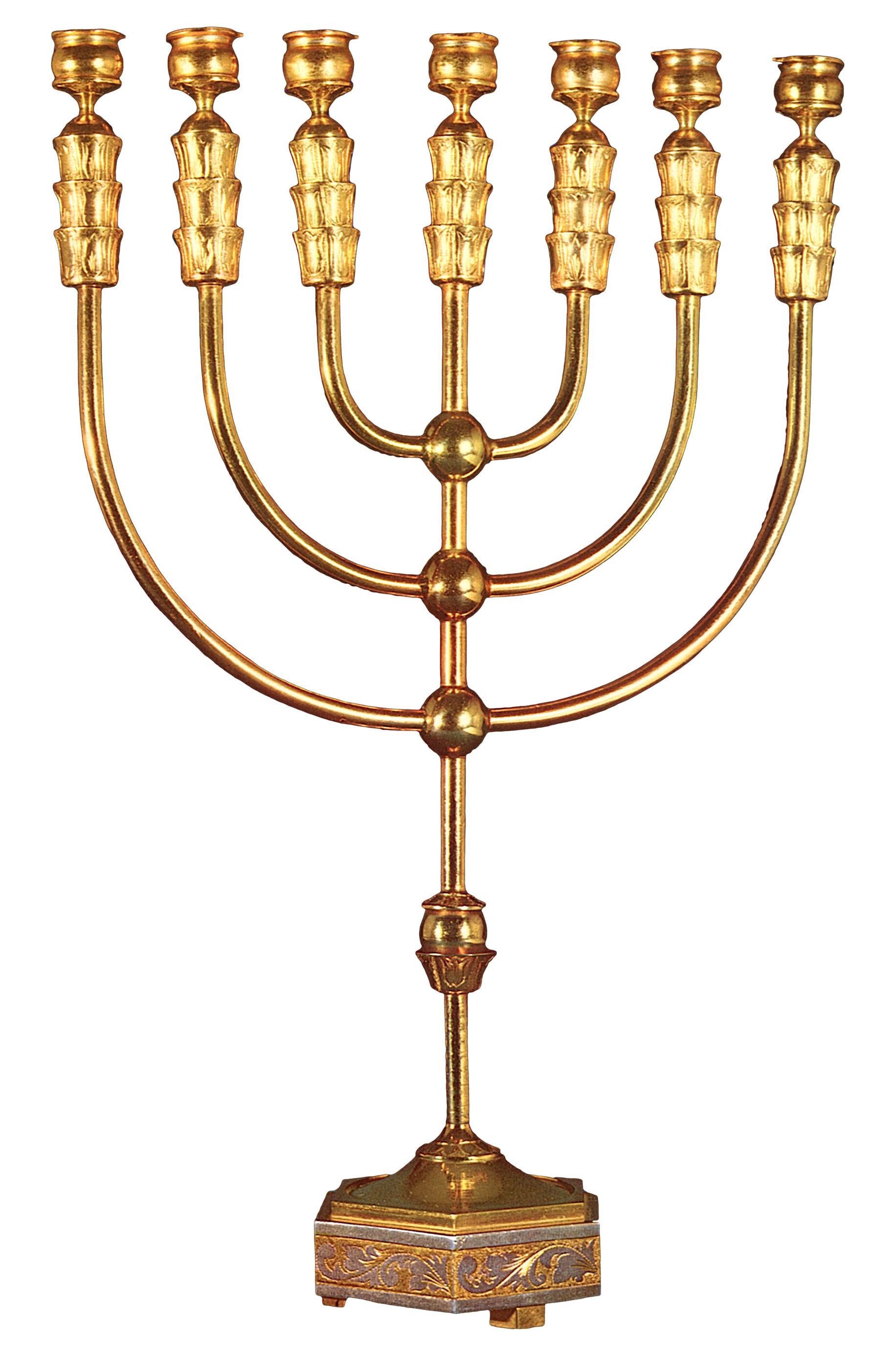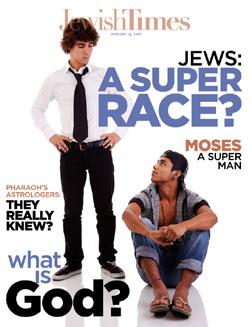
13 minute read
Menora
PARSHA
a Map to the Universe
Advertisement
RABBI MOSHE BEN-CHAIM
Unlike other religions toting arbitrarily-designed ceremonial objects and garb, and tapestries that express raw human fantasy…each of God’s Torah laws and designs are precise, containing fundamental intellectual and moral truths.
Of all the Temple’s vessels, the Menorah is most perplexing. As Einstein would not dismiss any order detected in the universe, we too cannot dismiss the Menorah’s intricate details. With them, God intends to share something profound with mankind. While some details may be technical, patient study of the Menorah is rewarded with new insights and increased appreciation for God’s design and purpose of this mitzvah, and of man. Without understanding the Menorah’s designs and laws, we miss His intended lessons.
Let us first identify the unique features of the Menorah, and then progress in an orderly manner to define those features. While there is much room for drash and allegory, it is vital for the sake of arriving at the true lessons of Menorah, that we do not overstep, or suggest ideas that are not loyal to Menorah’s designs and laws.
(CONT. ON NEXT PAGE)
Menorah’s Design
Unlike most other vessels, the Menorah was made of pure gold, like the Ark’s cover. Both could not be made in parts, and then subsequently assembled. They were both hammered into their final form from a single block of gold. Why?
Iconic to Menorah is its six branches emanating from a center seventh branch: three branches protruded from both sides, left and right, totaling six protruding branches, plus a seventh center stem. Why do the six branches emanate from the seventh; not standing on the ground independently, on six separate bases, just like the seventh stem?
On top of all seven branches was a basin for the oil. The wicks of all six branches faced towards the center stem: those on the right faced left, and those wicks on the left faced right. And the direction of the center stem’s wick faced towards the Holy of Holies. Why?
On each of the six branches were unusual designs: three cups, one flower and one sphere. On the center stem there was an additional cup, three additional spheres (out of which the six branches protruded), one additional set of a flower, cup and sphere, and finally one more flower at the base. The base had three legs.
We readily understand Moses’ perplexity of the Menorah’s design, that is, until God showed him a vision of it. We too wonder what these cups, flowers and spheres mean. And why were there more cups, than flowers and spheres? But the near duplication of design on all seven branches must teach something. And the seventh’s additional designs too teach another lesson. Furthermore, a miracle occurred that the center stem’s wick burned unnaturally longer than the other six branches.[1] What was the need for this miracle? What is that lesson?
In general, what is Menorah: a lamp? The Talmud states that God does not need light, for He lit our journey through the desert! King Solomon sought to highlight this unnecessary need for light precisely by designing the Temple’s windows narrow on the inside, and wider on the outside[2]. Menorah was not for the purpose of physical light.
Now, let’s proceed to answer this enigma, step-by-step…
What is Light?
“Nare mitzvah, v'Torah Or – A (single) flame is a command, and Torah is light (Proverbs, 6:22).”
Here, King Solomon alluded to a primary metaphor: wisdom is likened to light. Furthermore, the wisdom of one mitzvah illuminates to 'some' degree: a command is equated to one flame. While observing Torah entirely, removes all darkness. It is “light.” It is only with a broad understanding attained through observing "all" of Torah, that we see the truth in all areas, as if one walks in broad daylight. The Menorah, then, is not for God, as He needs nothing. The Menorah is to embody the concept of wisdom, light. And in Proverbs (chap. 8) King Solomon personifies wisdom as metaphorically “calling out to man.” Verse 19, wisdom says, “My fruit surpasses fine gold.” We thereby find Torah equating fine gold to wisdom. Therefore, Menorah’s light and requirement to be made of pure gold both attest to its equation to wisdom. Additionally, hammering the Menorah out of one gold block instead of making it through assembly requires greater wisdom, and embellishes this idea.
What wisdom does Menorah impart?
Six Branches = Six Days
The first step in answering this question, is to recognize Menorah’s unique aspects. Seven branches, where six emanate from the center seventh stem, clearly parallel the Six Days of Creation, and the Sabbath. Just as our first blessing each morning – “Baruch She’amar” – defines God as the God of creation, Temple equally requires this concept. The most primary notion of Temple service is that the nation firmly attests to God as the sole cause of the universe. Menorah delivers this message. Rashi on Exodus 28:6 cites Talmud Yuma regarding the priest’s clothing, that with every six strands of blue, purple, red and linen, there was wound a seventh strand of gold thread. Again, the concept of six days of Creation is highlighted.
But if, as Sforno teaches, subsequent to the sin of the Gold Calf, Temple came to correct man’s notions, what does Menorah correct?
Six Dependent Branches: The Physical is not Absolute
The sin of those who created the Gold Calf was that they viewed the physical world as what is truly “real.” They viewed tangible things as absolute truths, more true than the abstract metaphysical God to whom they could not relate.
In truth, the physical world, this universe, does not have to exist.
It does, only due to God’s kindness. The six branches “depend on the seventh,” as they
emanate from the latter. This teaches that the continued existence of the universe – the six days’ creations – depend on God’s will, as the universe cannot sustain itself. God willed all matter into creation, and He can equally will it out of existence. This design of six branches “depending” (suspended) on the seventh, corrects the fallacy harbored by the Gold Calf followers. They felt a physical object was “more real” than something abstract. “Arise and make for us a god that will go before us, for this Moses, the man, who took us up from Egypt, we know not what has become of him (Exod. 32:1).” Here, immediately prior to fashioning the Gold Calf, the Jews expressed their attachment to the “man” Moses. Our very point. But in fact, the physical world’s existence is flimsy, always depending on God’s will for its continued existence. “He renews every day regularly, the works of Creation (Daily Prayers).” The Menorah corrects the false notion of an absolute physical world. Six branches – six days of creation – are dependent on the seventh. Decoded, this hints to the physical world (six branches) as dependent on God’s will and His natural laws, or the metaphysical world, referred to as the seventh branch. The seventh branch – the sabbath – has as its goal man’s removal from physical creativity, and the engagement in wisdom.
What has Greater Reality?
We must realize that the universe is guided by metaphysical laws that are “outside” of the universe. And these laws are more real than the physical world, as they guide the physical world. If one thing guides another, the former is more real than the latter. Natural law is falsely viewed as “inside” all physical objects. But science likes simplicity. We do not say each body has its own law of gravity inside itself, in an attempt to explain why all elements fall after being lifted. Our minds say there is a “single” law of gravity that governs everything, and is external to all matter. Laws are metaphysical realities. We find this approach more pleasing and sensible. Similarly, God does not will each leaf to fall from every tree. Rather, we find far greater expression of God’s greatness by viewing such phenomena as a result of His “laws”, not His independent attention to each leaf. A law removes the need for individual attendance to all leaves. It is much more pleasing to our minds, and we view God greater with such an explanation.
The six branches depending on the seventh for their suspension, refers to the six days of Creation depending on metaphysical laws for their existence. The Gold Calf disease can be corrected by recognizing that physical objects are subjugated to the laws that govern them. To embellish this point, the seventh center stem had a miracle of its flame burning longer than its oil quantity could sustain. This demonstrated that the physical laws that typically would cause that flame to extinguish, were overridden by God’s will. Natural law can be altered by the metaphysical world, or God’s will.
To further express the subjugation of the physical word to the metaphysical, all six branches had their wicks pointing towards the center branch: a manner of deference. But interesting too is that the center branch itself had its wick pointing towards the Holy of Holies! This teaches that even those very metaphysical laws are not absolute, but they too are God’s creations, and subject to His will. (The Holy of Holies is from where God caused His communications to emanate.)
Spheres, Flowers & Cups: Harmony Reveals God’s Greatest Wisdom
Now we must address the Menorah’s unique decorations.
Each branch represents one of the six days of creation. Yet, despite the di erence in each day’s creations, all six branches are identical. What, then, must we say these cups, flowers and spheres refer to?
It would appear, what is identical on all days are the main categories of creation. I refer to substance, form, and properties, or function. Regardless of the specific created entities, all matter possesses these properties. And it is precisely by studying these properties that man attains God’s intended lessons. These are the areas of wisdom, which each day imparts.
As we study the universe, we identify numerous “elements.” Originally, man assumed there were four elements: earth, air, fire and water. But man later learned there exists over one hundred elements as identified in the Periodic Table. Varying properties of each element, from carbon to uranium, teach us about God’s universe.
We then witness various “forms” of creation, such as living species and minerals. For example, we learn from the di erent mouth structures of beasts, which are carnivores and which are vegetarians. Carnivores have much wider jaw openings and fanged teeth to help in their hunt and eating. Vegetarians, like cows, have smaller jaw openings. Fish have vertical fins, while mammals like dolphins and whales have horizontal fins in order to propel them upwards to rise above the surface for air.
But what imparts to man the greatest appreciation of God’s wisdom seen in creation, is the “functioning” of matter, or rather, the “systems” we witness. The solar system, digestive system, weather, etc. impress us most. And when many systems coexist and complement each other as is found in the human being's respiratory and circulatory systems, we are even more amazed. The reason a system is most impressive, is because it points to a greater plan, and thus, greater knowledge and planning, than in a single entity’s substance or form.
I suggest Menorah’s cups refer to creation’s properties and functions (systems), Menorah's flowers refer to form, and its spheres refer to raw amorphous substance. While Earth’s substances (Menorah’s amorphous sphere), and the form of all creations (Menorah’s flower) carry important lessons, Menorah’s cups (properties & systems) are more numerous on each branch. I believe this may indicate it is through studying the laws and systems of the universe whereby man attains the greatest appreciation of God’s wisdom. An apple is a beautiful creation, but when we study the revolution of the Moon and Earth, which cause seasons, combined with the precise distance of Earth from the Sun, and its axis, we are amazed at the plan, and with God. Therefore I believe there are more cups on each branch to emphasize this point that the study of the universe's functions—not substances or form—reveals greater wisdom.
Through our study of these three areas, we view God’s wisdom. Thus, each branch, each day of creation, intends to o er man expressions of God’s wisdom, as seen in elements like iron and hydrogen, in various forms like plants and animals, but mostly, “how” these creations operate, seen in the numerous systems that guide our universe, from the subatomic world, up to the birth of stars. (The reason we find cups, flowers and spheres on the seventh branch, despite the fact that no creation took place on day seven, is to teach that the physical creations of the six days are based on their metaphysical designs – the seventh branch.) The reason the six branches emanated from spheres (and not flowers or cups) on the center branch, teaches that the six days' creations were formed from that substance (sphere) that came into existence on the first day. That is, no new matter was created on days 2, 3, 4, etc. from which God formed the additional creations on those days; all creations on all days were made from the initial matter created from nothingness on day 1.
(CONT. ON NEXT PAGE)
Summary
Menorah is a lesson in the dependent and limited nature of the physical world. This world was created. Nothing demands it exists other than God's will. God also determined what properties all creations possess. Placing more trust in physical objects than in God, and certainly imagining physical things help us in any way other than through their natural properties, is foolish. We must not value Gold Calves more than God, who controls all physical entities, and prohibits their worship. However abstract He is and however emotionally displeasing we initially find it, we must follow our minds and strive to become convinced that physical entities cannot answer our prayers, be they Western Walls, red bendels, dead Rebbes, or Gold Calves. Instead, we are to follow God and His lessons. God provided manna. He performed numerous miracles. And although we are commanded to follow His natural laws and toil to earn our living and not rely on miracles, prayer teaches us that ultimately, God is the source of our success.
There exists a physical world with laws that govern who eats and who starves. Sitting idly while a farmer toils each season, the idle person dies of hunger while the farmer thrives. But the farmer who is a Torah Jew knows this: despite droughts, a righteous person ultimately relies on God, who can deliver his daily bread. The righteous Jew plans according to nature but relies on God to bring matters to success. He gives tzedaka without fear of diminishing wealth, and in fact views charity as a means of enriching his lot. And although he abstains from work each Sabbath, he does not fear this will diminish his wealth. God is his rock.
Menorah itself is an example that the details of God's creations must be studied to witness God’s wisdom: as we study every inch of the universe, we also study the Menorah and all other commands. Menorah's primary lesson is that the universe is subjugated to the metaphysical world, to God's will. Menorah corrects the flaw of the Gold Calf followers and hopefully will correct the false views of those Jews who still place their hopes in anything except God alone. ■
[1] Menachot 86b [2] Kings I, 6:4, Menachot 86b
Subscribe to the FREE Jewishtimes.
Subscribe by emailing: Join@Mesora.org







